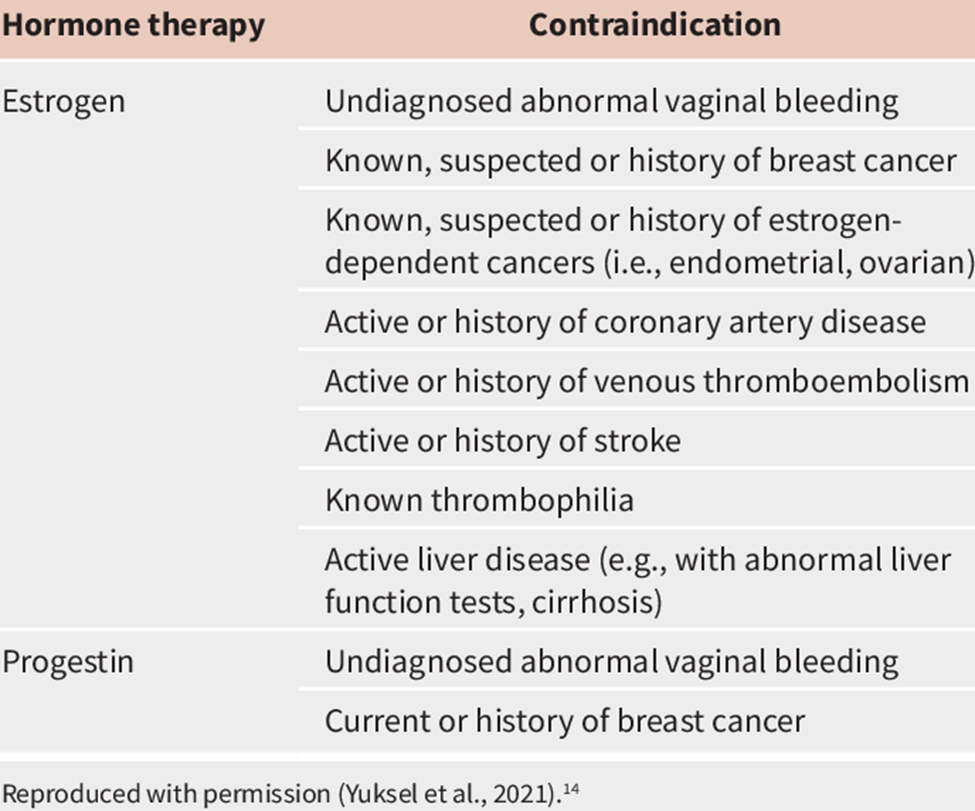A nurse is caring for a client who is experiencing menopausal symptoms and requests information about hormone replacement therapy (HRT). Which of the following items in the client's health history is a contraindication for hormone replacement therapy?
Concurrent treatment for GERD
History of breast cancer
History of dermatitis
Multiple hospitalizations for COPD
The Correct Answer is B
A. Concurrent treatment for GERD:
This is not typically a contraindication for hormone replacement therapy (HRT). GERD treatment is not directly related to the decision to use HRT.
B. History of breast cancer:
This is a contraindication for HRT. Estrogen replacement therapy has been associated with an increased risk of breast cancer. Therefore, individuals with a history of breast cancer are generally advised against using HRT.
C. History of dermatitis:
A history of dermatitis is not a contraindication for HRT. However, the decision to use HRT should be made based on a comprehensive assessment of the client's overall health and risk factors.
D. Multiple hospitalizations for COPD:
While COPD itself is not a contraindication for HRT, decisions about HRT should consider the individual's overall health status and potential risks. Factors such as smoking history and respiratory function may be considered in the assessment.

Nursing Test Bank
Naxlex Comprehensive Predictor Exams
Related Questions
Correct Answer is B
Explanation
A. Palliative care focuses on providing comfort and relief from symptoms for individuals with serious illnesses, often those with life-limiting conditions. Respite care is not specifically designed for palliative care but can complement it by offering temporary relief to caregivers.
B. Respite care is a form of temporary care that allows caregivers a break or time off from their responsibilities. It is intended to provide short-term relief and support for family members or caregivers who are taking care of individuals with chronic illnesses, disabilities, or age-related conditions.
C. Restorative care involves interventions and services aimed at improving an individual's functional abilities and promoting independence. Respite care is not primarily focused on restorative care but rather on giving caregivers a temporary break.
D. Pain management is a specialized area of care that focuses on assessing and treating pain. Respite care, while it may involve managing symptoms during the temporary care period, is not specifically designed for pain management.
Correct Answer is ["A","B","C","D"]
Explanation
A. Instruct the clients to use the call light.
Encouraging clients to use the call light enables them to request assistance when needed, reducing the risk of falls if they need help to move or get out of bed.
B. Move overbed tables away from the bed.
Clearing the area around the bed, including overbed tables, reduces obstacles and potential hazards that clients might trip over or get tangled in.
C. Place a fall risk wristband on each of the clients.
Identifying clients at risk for falls by using wristbands helps alert all healthcare staff to take necessary precautions and provide appropriate assistance to prevent falls.
D. Perform client checks every 4 hr.
Regular client checks allow the nurse to monitor their condition, reposition them if necessary, assist with toileting needs, and ensure they're safe, especially during the night when falls might be more likely.
E. Keep the clients' rooms dark.
Keeping the room dimly lit during the night can help clients sleep better but should still provide enough light for safe movement. Complete darkness might increase the risk of falls if clients need to move around.
Whether you are a student looking to ace your exams or a practicing nurse seeking to enhance your expertise , our nursing education contents will empower you with the confidence and competence to make a difference in the lives of patients and become a respected leader in the healthcare field.
Visit Naxlex, invest in your future and unlock endless possibilities with our unparalleled nursing education contents today
Report Wrong Answer on the Current Question
Do you disagree with the answer? If yes, what is your expected answer? Explain.
Kindly be descriptive with the issue you are facing.
